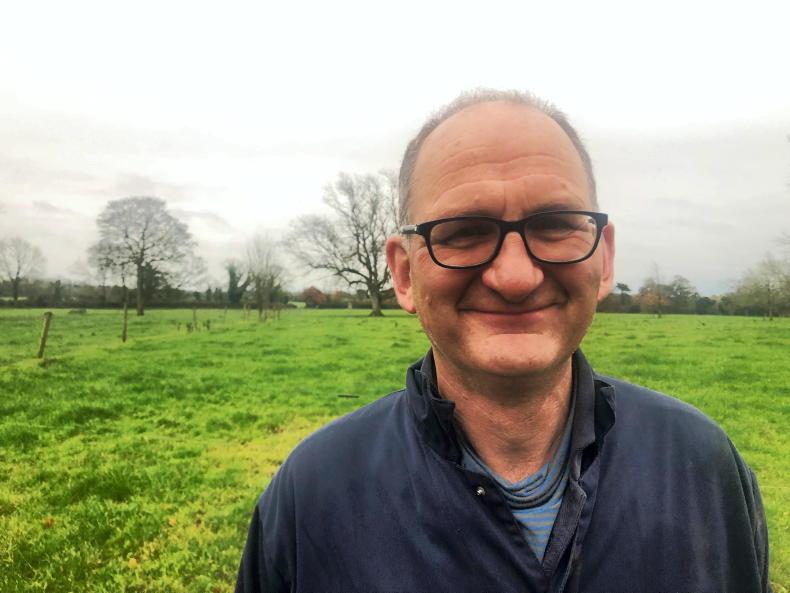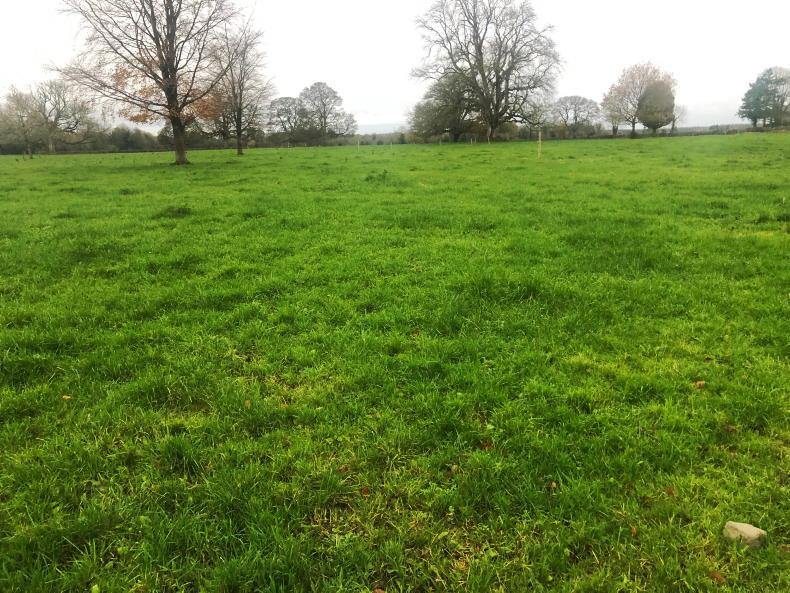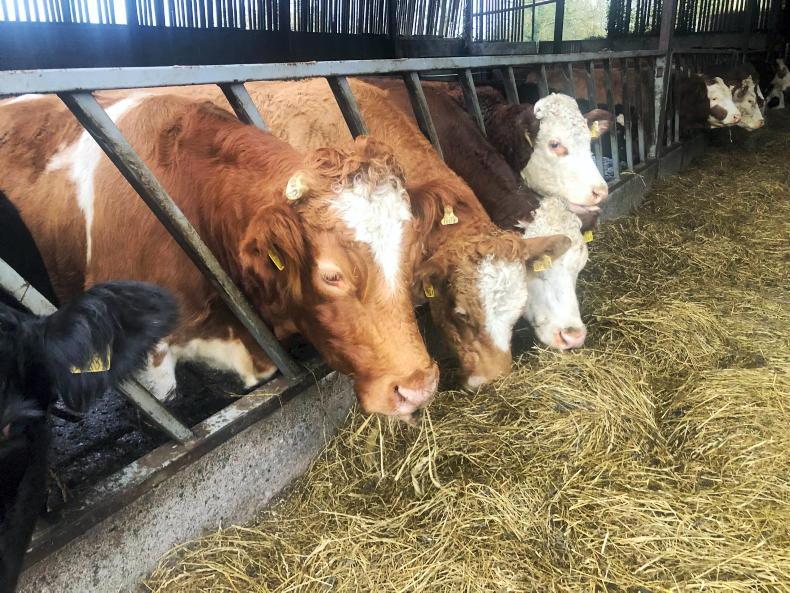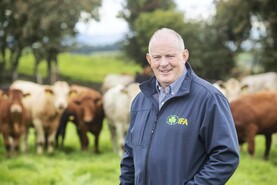How do you manage when fertiliser prices are headed for €1,000/t? Going organic could be an option. This week, we take a look at organic beef farming and whether it’s for everybody or just a select few.
What do you think of when someone says organic farming? I have to admit for myself I used to think of organic farming systems as something that could never survive in mainstream farming systems.
I was of the opinion that it was always going to be a niche system operating on a small scale.
My farm visit to Co Offaly organic beef farmer Ken Gill changed my perception completely and I’m ashamed to say I had a very poor understanding of the system and how organic farming systems work in a holistic way.

Ken Gill.
There are some who say it will always be a niche system but with the EU plan to increase land farmed organically to 25% of the EU agricultural land by 2030, it may be a system that more and more farmers will be looking at in the next few years.
Presently, about 8% of the EU’s agricultural area is in organic production with Ireland on one of the lowest at 2%,or 75,000ha.
This needs to rise to 350,000ha in organic production by 2030 if we are to meet the EU target.
The Government aims to spend €256m from 2023 to 2027, or €50m a year, a significant increase on the current €10m budget.
There was a 33% increase in the budget in 2021 (approximately €4m) with 317 successful applicants. There was a target of 400 to 500 applicants in 2021 and numbers fell short of that.
In the next round we are likely to see continued preferential access and higher payments for the dairy, tillage and horticulture sectors.

Teagasc organic expert Elaine Leavy says: “The sector is a relatively small sector, with organic cattle representing about 0.8% of the total cattle population in Ireland.
“In 2019, according to the Department of Agriculture, Food and the Marine, there were approximately 1,400 organic cattle farms in Ireland, most of which were suckler farms.
“Beef farmers currently make up about 70% of Irish organic farms with just 62 dairy farmers in organic production in 2019.”
Organic farming is very well supported through EU subsidies. Currently, €220/ha is available as an annual payment to organic farmers in conversion. This payment lasts for two years. The rate of payment drops down to €170/ha thereafter. There will also be preferential access for organic farmers to agri-environmental schemes in the next round of CAP, along with increased TAMS grants of 50% for capital expenditure on organic farms.
Currently, the market for beef is running about 50c/kg ahead of conventional beef. The weekly base price has risen from €4.95 in week 46 in mid-November to a guaranteed €5.30/kg for the first week of February.

This week’s price is quoted at €5.10/kg. No breed bonus or in-spec quality assurance bonus is paid on organic cattle. This puts the organic premium on an Aberdeen Angus bullock killed next week at 45c/kg or €144/head.
The base price is paid on R-, R= and R+ grading cattle at a fat score of between 2+ and 4+.
U grading cattle get a bonus of between 16c/kg to 18c/kg depending on fat score while O grading cattle receive a penalty of 18c/kg.
The bespoke grid based payment is for cattle aged between 13 and 35 months.
Cattle presented for slaughter must have been resident on a quality-assured farm for 90 days with a residency period of at least 30 days on the final farm. They must also have a maximum of four farm residencies.
The carcase weight required is between 250kg and 450kg. Penalties for carcase weights outside of this range from 20c/kg for carcase weights of 220kg to 250kg to 40c/kg for carcase weights from 490kg to 520kg.
Most of Ireland’s organic beef produce ends up in high-end retail chains across Europe and restaurants, with some also going into organic baby food.
Niche
The organic market is a niche market and the question remains as to whether organic production grows at the exponential rate at which the EU wants it to grow at. Is the market there for the increased production?
At the moment, you would really question whether a large proportion of UK and EU consumers are willing to pay a premium price for organic produce.
Consumers seem to like the idea of organic production but when it comes down to it, many don’t want to pay the premium price for the organic produce.
Ken Gill places huge emphasis on his crop rotation. Ken says: “Year one starts off with grass. This is then ploughed in July where a crop of turnips and kale is planted to graze in November and December of that year.

“Years two and three are spring oats. We then plough again in year four to put in a crop of red clover. This lasts for three years. We have to feed this crop quite a lot and it will get slurry after each cut. It also gets a good cover of dung in the autumn.
“Year seven is back to a crop of turnips and kale for winter grazing and then we go back to oats for a few years. This will vary from two to three years, depending on price and how they are growing. We have been getting €385/t for a 2t crop of oats/acre, so the temptation has been to increase the oats area over the last few years.
“We will then go back to a standard grass silage crop for a few years. With a good rotation, you are working with the soil and nature to put back what you are taking out in as natural way as possible. In my mind, it’s about farming the soil and feeding the soil, rather than the crop.”
Housing
There are some strict requirements around housing and lying area in organic systems.
Ken says: “You have to have 50% of the lying area as straw-bedded so we had to make a few changes here when we converted but we were lucky in that there were a lot of loose sheds on the farm anyway.
“It does put an extra cost on the system buying in straw but, to be honest, I couldn’t have enough farmyard manure on the farm. It’s such a good fertiliser so essentially I am making fertiliser during the winter in my straw-bedded sheds.”
Grassland management
Without the crutch of nitrogen fertiliser, grassland management needs to be very good on organic farms to make sure that cattle are grazing quality grass as opposed to stemmy pasture.
Ken says: “We couldn’t do it here without the paddocks. The paddock system means we have fresh grass coming on all the time, especially for our weanlings and finishing cattle. You just learn to live with slower rotation.
“In a conventional system you might be working with a 21-day rotation whereas in organics it goes out to 30 to 35 days. We were lucky in that we have good natural clover in some of our permanent pasture so that helps as well.
“We try and go out with some watery slurry in the springtime to give our grazing swards a boost and this helps. We sort of use the autumn dry cows as toppers during the summer and they will come in after our young cattle to clean off any paddocks that aren’t grazed out enough.”
Breeding
Ken went 100% AI for his breeding programme a few years ago and hasn’t looked back. The autumn calving system lends itself well to catching cows in heat in the shed.
The straw-bedded sheds are also a big help for heat detection.
Ken says: “I would love to get the breeding season back to six weeks. It would leave things really simple. I am working with a Simmental or Limousin cow and we are using Hereford and Angus sires. We have done a lot of work in trying to improve the quality of stock on our farm over the last few years and we are happy with the direction we are headed. “We are averaging at 300kg to 350kg carcase at around 22 to 24 months of age with good fat covers so there is nothing wrong with that.”
Ken works on a preventative principle through vaccinations and management to keep his cattle healthy. “We graze the weanlings and beef cattle together, so I think this helps. It was always a worry that something will go wrong but I think when the system isn’t a walking tight rope of high stocking rates cattle aren’t under as much pressure and are just healthier.
“If we have a serious problem, we can get a derogation to worm animals or treat a sick animal but to be honest that has been pretty rare so far.
How do you manage when fertiliser prices are headed for €1,000/t? Going organic could be an option. This week, we take a look at organic beef farming and whether it’s for everybody or just a select few.
What do you think of when someone says organic farming? I have to admit for myself I used to think of organic farming systems as something that could never survive in mainstream farming systems.
I was of the opinion that it was always going to be a niche system operating on a small scale.
My farm visit to Co Offaly organic beef farmer Ken Gill changed my perception completely and I’m ashamed to say I had a very poor understanding of the system and how organic farming systems work in a holistic way.

Ken Gill.
There are some who say it will always be a niche system but with the EU plan to increase land farmed organically to 25% of the EU agricultural land by 2030, it may be a system that more and more farmers will be looking at in the next few years.
Presently, about 8% of the EU’s agricultural area is in organic production with Ireland on one of the lowest at 2%,or 75,000ha.
This needs to rise to 350,000ha in organic production by 2030 if we are to meet the EU target.
The Government aims to spend €256m from 2023 to 2027, or €50m a year, a significant increase on the current €10m budget.
There was a 33% increase in the budget in 2021 (approximately €4m) with 317 successful applicants. There was a target of 400 to 500 applicants in 2021 and numbers fell short of that.
In the next round we are likely to see continued preferential access and higher payments for the dairy, tillage and horticulture sectors.

Teagasc organic expert Elaine Leavy says: “The sector is a relatively small sector, with organic cattle representing about 0.8% of the total cattle population in Ireland.
“In 2019, according to the Department of Agriculture, Food and the Marine, there were approximately 1,400 organic cattle farms in Ireland, most of which were suckler farms.
“Beef farmers currently make up about 70% of Irish organic farms with just 62 dairy farmers in organic production in 2019.”
Organic farming is very well supported through EU subsidies. Currently, €220/ha is available as an annual payment to organic farmers in conversion. This payment lasts for two years. The rate of payment drops down to €170/ha thereafter. There will also be preferential access for organic farmers to agri-environmental schemes in the next round of CAP, along with increased TAMS grants of 50% for capital expenditure on organic farms.
Currently, the market for beef is running about 50c/kg ahead of conventional beef. The weekly base price has risen from €4.95 in week 46 in mid-November to a guaranteed €5.30/kg for the first week of February.

This week’s price is quoted at €5.10/kg. No breed bonus or in-spec quality assurance bonus is paid on organic cattle. This puts the organic premium on an Aberdeen Angus bullock killed next week at 45c/kg or €144/head.
The base price is paid on R-, R= and R+ grading cattle at a fat score of between 2+ and 4+.
U grading cattle get a bonus of between 16c/kg to 18c/kg depending on fat score while O grading cattle receive a penalty of 18c/kg.
The bespoke grid based payment is for cattle aged between 13 and 35 months.
Cattle presented for slaughter must have been resident on a quality-assured farm for 90 days with a residency period of at least 30 days on the final farm. They must also have a maximum of four farm residencies.
The carcase weight required is between 250kg and 450kg. Penalties for carcase weights outside of this range from 20c/kg for carcase weights of 220kg to 250kg to 40c/kg for carcase weights from 490kg to 520kg.
Most of Ireland’s organic beef produce ends up in high-end retail chains across Europe and restaurants, with some also going into organic baby food.
Niche
The organic market is a niche market and the question remains as to whether organic production grows at the exponential rate at which the EU wants it to grow at. Is the market there for the increased production?
At the moment, you would really question whether a large proportion of UK and EU consumers are willing to pay a premium price for organic produce.
Consumers seem to like the idea of organic production but when it comes down to it, many don’t want to pay the premium price for the organic produce.
Ken Gill places huge emphasis on his crop rotation. Ken says: “Year one starts off with grass. This is then ploughed in July where a crop of turnips and kale is planted to graze in November and December of that year.

“Years two and three are spring oats. We then plough again in year four to put in a crop of red clover. This lasts for three years. We have to feed this crop quite a lot and it will get slurry after each cut. It also gets a good cover of dung in the autumn.
“Year seven is back to a crop of turnips and kale for winter grazing and then we go back to oats for a few years. This will vary from two to three years, depending on price and how they are growing. We have been getting €385/t for a 2t crop of oats/acre, so the temptation has been to increase the oats area over the last few years.
“We will then go back to a standard grass silage crop for a few years. With a good rotation, you are working with the soil and nature to put back what you are taking out in as natural way as possible. In my mind, it’s about farming the soil and feeding the soil, rather than the crop.”
Housing
There are some strict requirements around housing and lying area in organic systems.
Ken says: “You have to have 50% of the lying area as straw-bedded so we had to make a few changes here when we converted but we were lucky in that there were a lot of loose sheds on the farm anyway.
“It does put an extra cost on the system buying in straw but, to be honest, I couldn’t have enough farmyard manure on the farm. It’s such a good fertiliser so essentially I am making fertiliser during the winter in my straw-bedded sheds.”
Grassland management
Without the crutch of nitrogen fertiliser, grassland management needs to be very good on organic farms to make sure that cattle are grazing quality grass as opposed to stemmy pasture.
Ken says: “We couldn’t do it here without the paddocks. The paddock system means we have fresh grass coming on all the time, especially for our weanlings and finishing cattle. You just learn to live with slower rotation.
“In a conventional system you might be working with a 21-day rotation whereas in organics it goes out to 30 to 35 days. We were lucky in that we have good natural clover in some of our permanent pasture so that helps as well.
“We try and go out with some watery slurry in the springtime to give our grazing swards a boost and this helps. We sort of use the autumn dry cows as toppers during the summer and they will come in after our young cattle to clean off any paddocks that aren’t grazed out enough.”
Breeding
Ken went 100% AI for his breeding programme a few years ago and hasn’t looked back. The autumn calving system lends itself well to catching cows in heat in the shed.
The straw-bedded sheds are also a big help for heat detection.
Ken says: “I would love to get the breeding season back to six weeks. It would leave things really simple. I am working with a Simmental or Limousin cow and we are using Hereford and Angus sires. We have done a lot of work in trying to improve the quality of stock on our farm over the last few years and we are happy with the direction we are headed. “We are averaging at 300kg to 350kg carcase at around 22 to 24 months of age with good fat covers so there is nothing wrong with that.”
Ken works on a preventative principle through vaccinations and management to keep his cattle healthy. “We graze the weanlings and beef cattle together, so I think this helps. It was always a worry that something will go wrong but I think when the system isn’t a walking tight rope of high stocking rates cattle aren’t under as much pressure and are just healthier.
“If we have a serious problem, we can get a derogation to worm animals or treat a sick animal but to be honest that has been pretty rare so far.










 This is a subscriber-only article
This is a subscriber-only article











SHARING OPTIONS: